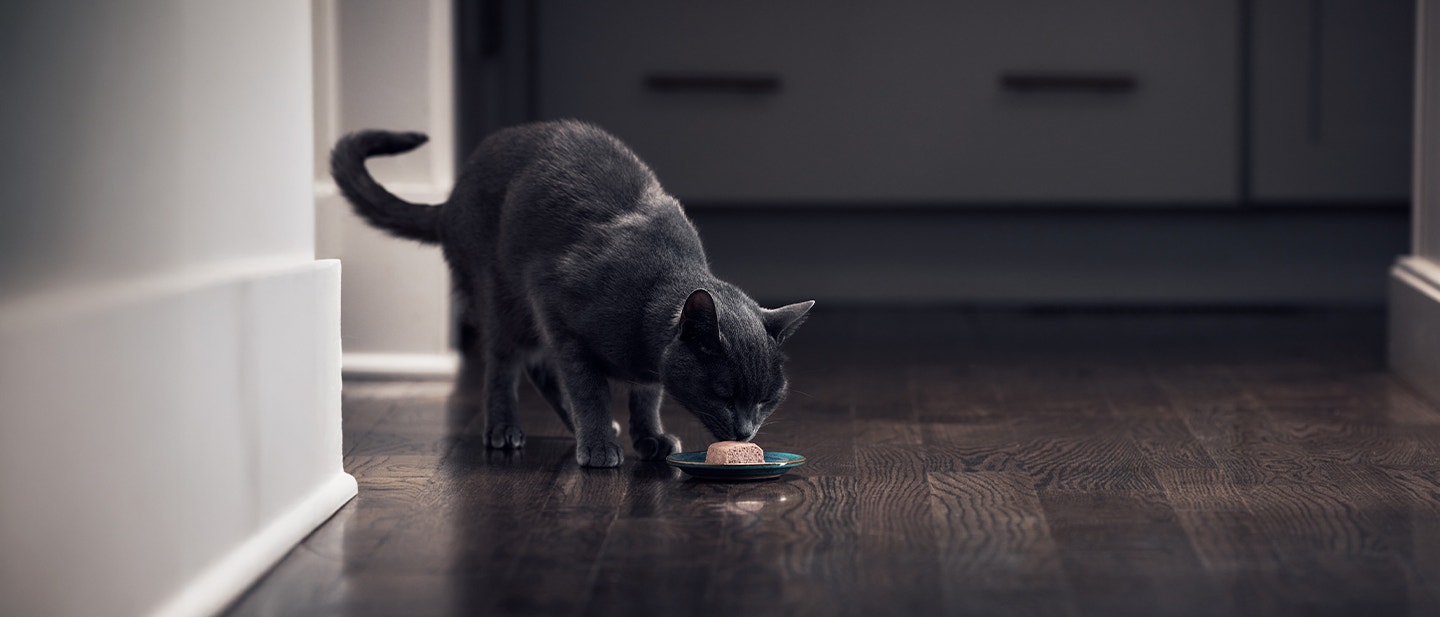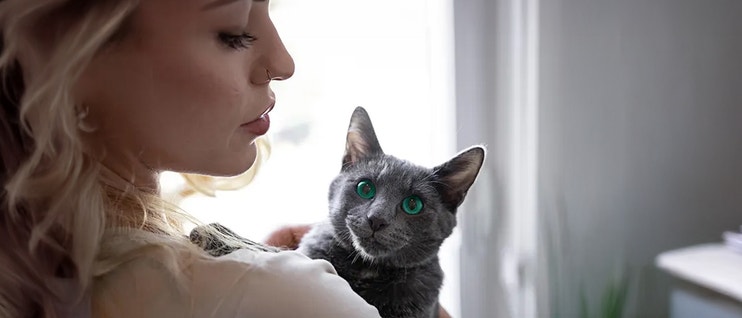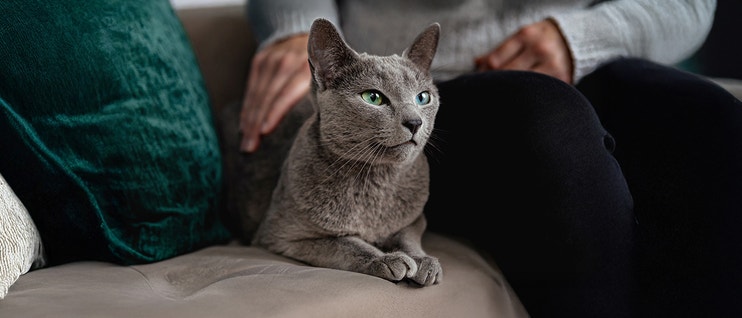
How Often Should I Feed My Cat? | A Guide for Pet Parents
When you have the right information, the answer to the question, “How often should I feed my cat?” is fairly easy.
That said, before you pick a number out of a hat and decide that’s the number of meals your cat should have every day, there are details about your feline friend that you need to take into account.
We’ve created this guide to help you feed your cat well throughout its entire life.
Table of Contents

How Often Should I Feed My Cat?
Every cat is different and, as every proud pet parent knows, each one has their own unique personality(open in new tab) and preferences. Because of that, there’s no one-size-fits-all answer to the question, “How often should I feed my cat?”
But that doesn’t mean you have to guess and hope you get it right! There are some general guidelines you can use to help you figure out what works best for your feline friend.
Here are six factors to consider when trying to decide how often to feed your cat.
Factors To Consider
Age
Age is one of the most influential factors when it comes to determining how often to feed your cat.
Kittens(open in new tab) grow bigger, stronger, and more coordinated every day, and it takes a lot of energy and nutrients to support this development. Because of that, they often need to eat more frequently than adult cats — sometimes four or five times a day until they’re six months old!
Once your cat reaches the adult stage of their life, their growth and development slows down and eventually stops altogether. When this happens, they’ll typically settle into eating two or three meals a day depending on the other factors on this list.
In the senior stage(open in new tab) of their life, your cat may eat even less often than they did when they were an adult (and certainly less often than they did when they were a kitten) — and that’s OK.
A senior cat’s metabolism will slow down and they’ll be less active when compared to kittens and adults. As a result, they won’t need as many calories to maintain their health and won’t need to eat as often to get those calories.
Keep in mind that the above are general guidelines. It’s always important to check with a vet for unique feeding recommendations for your cat.
Weight
All cats have an ideal body weight that indicates whether they’re at their ideal weight, overweight, or underweight. When deciding how often to feed your cat, you want to do your best to help them maintain a healthy weight for their breed, age, and activity level.
Feeding your cat enough (but not too much) high-quality cat food several times a day goes a long way toward keeping them close to their ideal body condition.
But how do you know if your cat is underweight or overweight? Have them checked out by a vet. They’ll be able to pinpoint the perfect weight for your cat and give you guidance on how often to feed your feline friend so they’re as happy and healthy as possible.
Activity Level
The more active your cat is, the more food they’ll need to maintain that lifestyle.
But your cat will only eat so much at one time without getting sick. Naturally, they’ll avoid overeating whenever possible, but they’ll then have to eat more often to keep their energy levels high.
As a general rule of thumb, active cats that run, explore, and play will need to eat three or even four meals throughout the day. On the other side of the coin, sedentary cats that like to sleep on your couch all day will need less food and may be happy eating just two meals a day.
Monitor your cat’s activity level and adjust their feeding schedule accordingly.

Indoor vs. Outdoor
If your cat lives outdoors — or spends most of their day outside — they’ll typically need more food to support a healthy weight and maintain an appropriate body temperature (especially during the cold months). As a result, you may have to feed them three or four times a day.
Cats that spend the majority of their time indoors will typically need less food and will eat less often than their outdoor counterparts.
Keep in mind that these are just generalizations. You may find that your indoor cat wants to eat more often than your outdoor cat. That’s OK, too. As long as you’re feeding them enough to maintain a healthy weight and an active lifestyle, they’ll be just fine!
Health Needs
Certain health conditions may require that you feed your cat more often throughout the day. For example, spaying or neutering your cat can affect their metabolism(open in new tab), so you may need to feed them less often right after surgery. As they recover, so will their appetite.
If you have any concerns about how a particular condition will affect your cat’s appetite, talk to your veterinarian to determine the best feeding plan for your cat’s needs.

Your Schedule
For busy pet parents, feeding your feline friend twice a day — before you leave for work and when you get home from work — might be the easiest way to give your cat what they need.
If you’re home all day(open in new tab) or have a more flexible schedule, you may consider feeding your cat three or four times per day.
Your four-legged friend will let you know if they like more frequent feedings or if they prefer the twice-a-day schedule that’s the norm for most adult cats.
Your Cat’s Schedule
For particularly finicky cats, you may have to adjust feeding times to their schedule.
For example, a young adult cat (an extremely intelligent orange female, by the way) is very much the princess and refuses to eat(open in new tab) before mid-morning (unlike her less-picky brother, who doesn’t care when you feed him as long as you put plenty in his bowl).
Cats will do what cats want to do, and there’s very little that we humans can do to change that behavior. Sometimes the easiest thing to do is bend to their will(open in new tab) and move your feeding schedule to meet theirs.

Feeding Tips for Cat Parents
Get Your Cat on a Feeding Schedule
As much as possible, find a feeding schedule that works for you and your feline friend and stick to it. Once your cat adapts to the routine, changing things up could lead to digestive issues or cause them to become anxious and express their displeasure in a variety of ways (rebellion is a very real possibility).
Measure Out the Right Portion
Overweight cats are at higher risk of developing a variety of health problems, including diabetes, joint pain, and heart disease.
On the other hand, underweight cats are more at risk of developing health problems, too, including weakened immune system, inability to fight off infections, and difficulty coping with minor injuries or diseases.
To keep your cat’s weight as ideal as possible, follow the serving recommendations on your cat’s food packaging or consult your veterinarian to determine how much food your cat needs based on age, weight, and activity level.
Choose a High-Quality Cat Food
One of the best things you can do for your cat is feed them high-quality(open in new tab), nutritionally balanced cat food that meets all their needs.
SHEBA®(open in new tab) is an excellent choice! We offer a variety of flavors and formulas for kittens and adult cats that are packed full of flavor and nutrition. With SHEBA®, your cat will look forward to meals again.
Provide a Bit of Variety
While cats are definitely creatures of habit and prefer consistent mealtimes, they do like a little variety in what they eat every day. That’s why we recommend mixing up their diet every so often.
You might choose to alternate between wet and dry food every other meal, combine wet and dry food together every time, or even try different flavors and textures within the same brand.
To keep things interesting for your cat, try creating different flavors combinations and textures with SHEBA® Premium Cat Food.

Indulge Your Cat with SHEBA® Cat Food
Once you understand the answer to the question, “How often should I feed my cat?” and get your feline friend on a regular eating schedule, you can focus on what your cat really wants: to be indulged.
That’s where the SHEBA® Brand comes in.
We offer four delicious varieties of gourmet wet cat food, including:
All of our tasty formulas are packed with high-quality protein, are grain-free, and are crafted with essential vitamins and minerals to help support your cat’s overall health and well-being.
And, each of the delicious flavors — of which there are many — comes in an easy-to-peel twin pack that allows you to deliver your feline friend the ideal serving every time without messy leftovers.
So, don’t just feed your cat, feed them well by following the tips in this article and serving up the perfect portion of delicious SHEBA® Premium Cat Food(open in new tab). Your cat will thank you!




